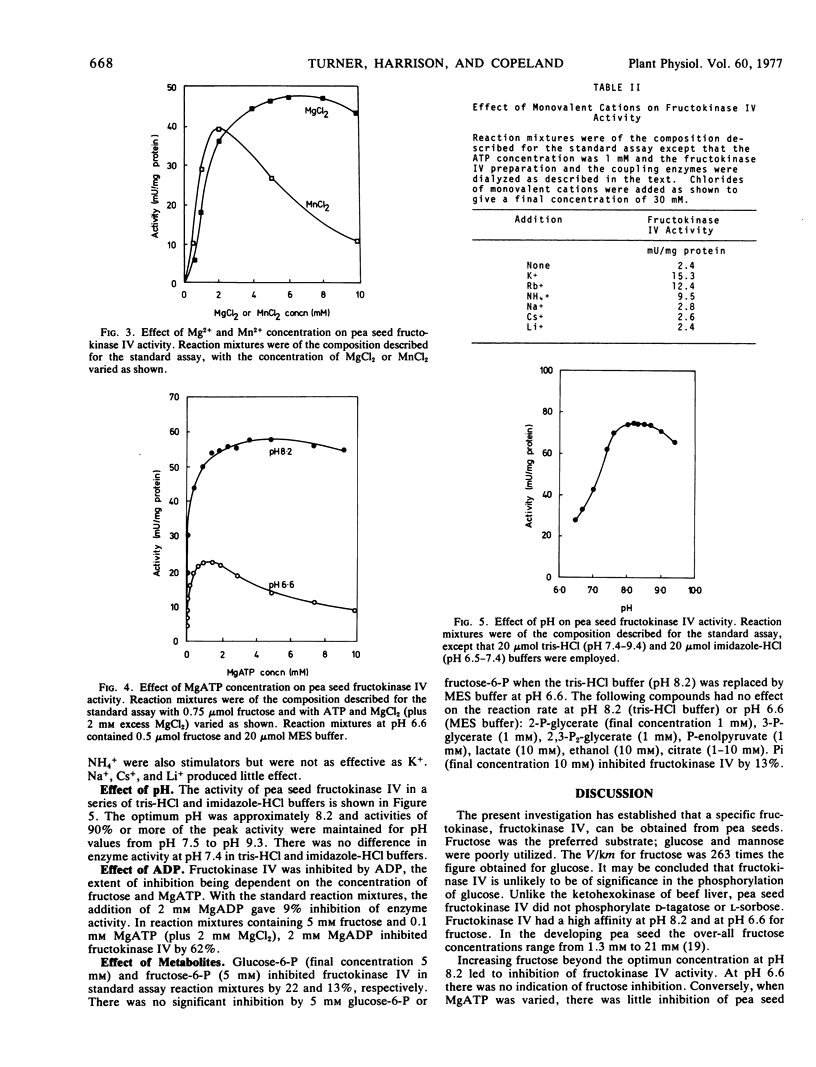Abstract
A fructokinase (EC 2.7.1.4) was obtained from pea (Pisum sativum L.) seeds. This enzyme, termed fructokinase (fraction IV), was specific for fructose as substrate and had little activity with glucose or mannose. Excess fructose inhibited the enzyme at the optimum pH (8.2) but not at pH 6.6. MgATP was inhibitory at pH 6.6. The apparent Michaelis-Menten constants at pH 8.2 were 0.057 mm for fructose and 0.10 mm for MgATP. Mg2+ ions were essential for activity; Mn2+ could partially replace Mg2+. Fructokinase (fraction IV) had a requirement for K+ ions which could be substantially replaced by Rb+ or NH4+ but not by Na+. The enzyme was inhibited by MgADP. The possible significance of fructokinase (fraction IV) in plant carbohydrate metabolism is discussed.
Full text
PDF



Selected References
These references are in PubMed. This may not be the complete list of references from this article.
- DIPIETRO D. L., SHARMA C., WEINHOUSE S. Studies on glucose phosphorylation in rat liver. Biochemistry. 1962 May 25;1:455–462. doi: 10.1021/bi00909a014. [DOI] [PubMed] [Google Scholar]
- HERS H. G. La fructokinase du foie. Biochim Biophys Acta. 1952 Apr;8(4):416–423. doi: 10.1016/0006-3002(52)90067-x. [DOI] [PubMed] [Google Scholar]
- MEDINA A., SOLS A. A specific fructokinase in peas. Biochim Biophys Acta. 1956 Feb;19(2):378–379. doi: 10.1016/0006-3002(56)90445-0. [DOI] [PubMed] [Google Scholar]
- Meunier J. C., Buc J., Ricard J. Purification and characterization of wheat germ hexokinases. FEBS Lett. 1971 Apr 12;14(1):25–28. doi: 10.1016/0014-5793(71)80266-1. [DOI] [PubMed] [Google Scholar]
- PARKS R. E., Jr, BEN-GERSHOM E., LARDY H. A. Liver fructokinase. J Biol Chem. 1957 Jul;227(1):231–242. [PubMed] [Google Scholar]
- Purich D. L., Fromm H. J., Rudolph F. B. The hexokinases: kinetic, physical, and regulatory properties. Adv Enzymol Relat Areas Mol Biol. 1973;39:249–326. doi: 10.1002/9780470122846.ch4. [DOI] [PubMed] [Google Scholar]
- Raushel F. M., Cleland W. W. The substrate and anomeric specificity of fructokinase. J Biol Chem. 1973 Dec 10;248(23):8174–8177. [PubMed] [Google Scholar]
- SALAS J., SALAS M., VINUELA E., SOLS A. GLUCOKINASE OF RABBIT LIVER. J Biol Chem. 1965 Mar;240:1014–1018. [PubMed] [Google Scholar]
- SALTMAN P. Hexokinase in higher plants. J Biol Chem. 1953 Jan;200(1):145–154. [PubMed] [Google Scholar]
- TURNER J. F. The biosynthesis of sucrose. Biochem J. 1957 Nov;67(3):450–456. doi: 10.1042/bj0670450. [DOI] [PMC free article] [PubMed] [Google Scholar]
- Tomlinson J. D., Turner J. F. Pyruvate kinase of higher plants. Biochim Biophys Acta. 1973 Nov 2;329(1):128–139. doi: 10.1016/0304-4165(73)90015-9. [DOI] [PubMed] [Google Scholar]
- Turner J. F., Chensee Q. J., Harrison D. D. Glucokinase of pea seeds. Biochim Biophys Acta. 1977 Feb 9;480(2):367–375. doi: 10.1016/0005-2744(77)90029-8. [DOI] [PubMed] [Google Scholar]


